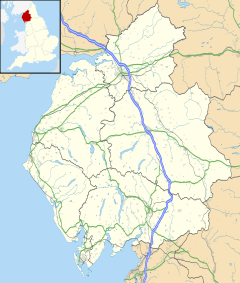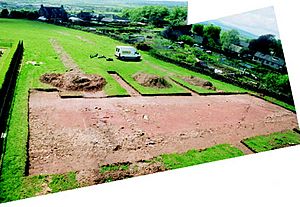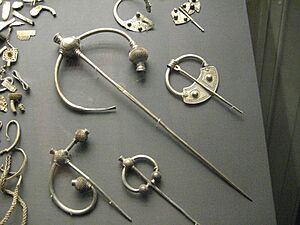Penrith, Cumbria facts for kids
Quick facts for kids Penrith |
|
|---|---|
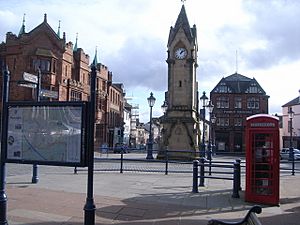 The Market Square |
|
 Flag |
|
| Population | 16,984 (2021 census) |
| Demonym | Penrithian |
| OS grid reference | NY515305 |
| Unitary authority |
|
| Ceremonial county | |
| Region | |
| Country | England |
| Sovereign state | United Kingdom |
| Post town | PENRITH |
| Postcode district | CA10, CA11 |
| Dialling code | 01768 |
| Police | Cumbria |
| Fire | Cumbria |
| Ambulance | North West |
| EU Parliament | North West England |
| UK Parliament |
|
Penrith (/ˈpɛnrɪθ/, /pɛnˈrɪθ/) is a market town and civil parish in the Westmorland and Furness district of Cumbria, England. It is less than 3 miles (5 km) outside the Lake District National Park and about 17 miles (27 km) south of Carlisle. It is between the Rivers Petteril and Eamont and just north of the River Lowther. The town had a population of 15,181 at the 2011 census. It is part of historic Cumberland.
From 1974 to 2015, it was an unparished area with no local council. A civil parish was reintroduced on 1 April 2015 with the first election for Penrith Town Council on 7 May 2015. The town was previously part of the 1974-created Eden District until 2023.
Contents
Toponymy
The etymology of "Penrith" has been debated. Several writers argue for the Cumbric or Welsh pen "head, chief, end" (both noun and adjective) with the Cumbric rid, Welsh rhyd "ford", to mean "chief ford", "hill ford", "ford end", or Whaley's suggestion: "the head of the ford" or "headland by the ford".
The centre of Penrith, however, lies about 1 mile (1.6 km) from the nearest crossing of the River Eamont at Eamont Bridge. An alternative has been suggested consisting of the same pen element meaning "head, end, top" + the equivalent of Welsh rhudd "crimson". Research on the medieval spelling variants of Penrith also suggests this alternative etymology. The name "red hill" may refer to Beacon Hill, to the north-east of today's town. There is also a place called Redhills to the south-west, near the M6 motorway, and a place called Penruddock, about 6 miles (9.7 km) west of Penrith. These names all reflect the local geology, as red sandstone is abundant in the area and was used for many buildings in Penrith.
Prehistory
The origins of Penrith go far back in time. There is archaeological evidence of "early, concentrated and continuous settlement" in the area. The Neolithic (c. 4500–2350 BCE) or early-Bronze Age (c. 2500–1000 BCE) sites at nearby Mayburgh Henge, King Arthur's Round Table, Little Round Table, Long Meg and Her Daughters, and Little Meg, and the stone circles at Leacet Hill and Oddendale are some of the visible traces of "one of the most important groups of prehistoric ritual sites in the region." In addition there have been various finds (stone axes, hammers, knives) and carvings found in the Penrith area.
For the Celtic (Iron Age) era (c. 800 BCE – 100 CE), nearby Clifton Dykes has been proposed as the centre of the Carvetti tribe, due to the large enclosure discovered there and assumptions about the strategic position of the Penrith area in the communications systems running north–south through the Eden Valley and east–west across Stainmore.
Roman period
Penrith itself was not established by the Romans, but they recognised the strategic importance of the place, especially near the confluence of the rivers Eamont and Lowther, where the Roman road crossing the Pennines (the present A66) came through. In doing so, they built the fort at Brougham (Brocavum) along with another road (the present A6) going north over Beacon Hill to the large fort at Plumpton (Voreda) – and from there northwards to Carlisle (Luguvallium). Brocavum may also have been built in order to have a military presence close to the centre of the Carvetti.
The Roman fort of Voreda occupied the site now known as Old Penrith, five miles north of the town. The 18th-century antiquarian and vicar of Penrith, Dr.Hugh Todd, speculated that the Ala I Petriana may have been stationed there, giving its name to the subsequent town, but see the "Toponymy" section above.
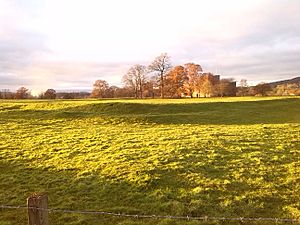
The Roman road from Manchester to Carlisle ran through the area. Excavations before an extension to Penrith Cemetery showed the road had survived better at the edges of the field. The cobble and gravel surfaces seemed to have been ploughed out at the centre. The road was constructed by excavating a wide, shallow trench below subsoil level. Large cobbles were probably obtained nearby, as they did not appear frequently in the subsoil in the excavated area. They were added to the excavated subsoil dumped back into the cut to form a stable foundation, canted at the centre of the road.
The two forts close to where Penrith is today would have had a vicus, an ad-hoc civilian settlement nearby, where farmers supplying food to the forts, and traders and others supplying goods and services lived and died. There is evidence of continuous settlement throughout the Roman period and into the post-Roman era.
History
Penrith's history has been defined primarily by its strategic position on vital north–south and east–west communications routes. This was especially important in its early history, when Anglo-Scottish relations were fraught. Furthermore, Penrith was a Crown possession in its early phase, though often granted to favoured noble families. It did not become a chartered borough or a municipal corporation and had no representation in Parliament. It also gained growth from its proximity to the Inglewood Forest and to the fertile Eden valley, and largely depended upon agriculture, especially cattle rearing and droving.
Early medieval period
After the departure of the Romans (c. 450 CE), the north became a patchwork of warring Celtic tribes (Hen Ogledd). One of these may have been Rheged, perhaps with a centre in the Eden valley and covering the area formerly held by the Carvetti. However, this has been disputed by historians. The Rheged Centre, just outside Penrith, commemorates the name.
During the 7th century, the region was invaded by the Angles, a Germanic tribe which moved west from Northumbria. The Celtic place-names in the region such as Penrith, Blencow, Culgaith, Penruddock, were now joined by settlements ending in "-ham" (estate) and "-ton" (farm), such as Askham, Barton, Clifton, Plumpton and Stainton.
From about 870, the area became subject to Viking settlement by Norse from Dublin and the Hebrides, along with Danes from Yorkshire. Settlements with names ending in "-by" ("village") and "-thorpe" ("hamlet") were largely on higher ground – the Vikings were pastoralists, the Angles arable farmers. Examples are Melkinthorpe, Langwathby, Lazonby, and Ousby. Little and Great Dockray (not to be confused with the nearby village Dockray) in Penrith itself are Norse names.
The Penrith Hoard of Viking silver brooches was found in the Eden valley at Flusco Pike, Penrith, as were 253 pieces of silver at Lupton.

Two cross-shafts and four hogbacks, along with a small cross found immediately to the west of St Andrew's Church, known as the "Giant's Grave" and "Giant's Thumb" (c. 920s), have long prompted speculation. They may have been separate items brought together by an antiquary or they may be a genuine group. They appear to be an Anglo-Norse fusion of Christian and Norse motifs, but it is still debated whether they are linked to the King of the Strathclyde Cumbrians, Owain ap Dyfnwal (fl. 934). It is thought that Strathclyde British had settled in parts of north Cumbria in the 10th century.
On 12 July 927, Eamont Bridge (or possibly the monastery at Dacre, Cumbria, or the site of the old Roman fort at Brougham or even the church at Penrith, or a combination of these) was the scene of a gathering of kings from throughout Britain as recorded in the Anglo-Saxon Chronicle and the histories of William of Malmesbury and John of Worcester. Present were Athelstan, King of the Anglo-Saxons and then of the English, Constantín mac Áeda (Constantine II), King of Scots, Owain of Strathclyde, King of the Cumbrians, Hywel Dda, King of Wales, and Ealdred son of Eadulf, Lord of Bamburgh. Athelstan took the submission of some of these other kings, presumably to form some sort of coalition against the Vikings. The growing power of the Scots and perhaps of the Strathclyders, may have persuaded Athelstan to move north and attempt to define the boundaries of the various kingdoms. This is generally taken as the date of foundation of the Kingdom of England, whose northern boundary was the Eamont river, with Westmorland outside the control of Strathclyde. Penrith was effectively held by the Scottish king as overlord of the Strathclyde Cumbrians, until the Norman takeover in 1092. Thereafter Penrith's fortunes varied according to the state of play between England and Scotland over ownership of Cumberland, Westmorland and Northumbria.
Penrith may have been founded before the arrival of the Normans. A ditched oval enclosure surrounding the area now occupied by St Andrew's Church (a burh - hence "Burrowgate") has been excavated. A church on the site may date back to the time of Bishop Wilfrid, (c. 670s) whose patron saint was Saint Andrew.
Later medieval period: Normans and Plantagenets
The Norman conquest of north Cumbria took place in 1092 under William Rufus, who retained Carlisle, Penrith and some other manors round Penrith as demesne. The Norman and Plantagenet rulers thereafter held Penrith as a crown estate ("Penred Regis"), along with a group of others locally, including Carlatton, Castle Sowerby, Gamblesby, Glassonby, Langwathby, Great Salkeld, Little Salkeld and Scotby. The group became known as the "Queen's Hames" ("Queen's Homes") from 1330 onwards.
Membership of the group fluctuated over time. In 1187 a sub-set including Penrith, Langwathby, Great Salkeld, Gamblesby, Glassonby and Scotby was referred to as the Honour of Penrith. From 1242 to 1295, the Honour of Penrith (created "the liberty of Penrith" by the Treaty of York in 1237) was in the hands of the King of Scots, in return for renouncing his claims to Northumberland, Cumberland and Westmorland. King Henry III had been reluctant to cede Penrith to the Scots, as it was a good source of Crown income: the right to hold a market and fair was granted in 1223 by Henry, and arable farming produced good yields and taxes. Tensions between the English Crown's agents in Cumberland and the Scottish agents attempting to defend the rights of the Scottish king and his tenants in the liberty of Penrith, may have influenced the mindset of the Scots leading up to the outbreak of the Wars of Scottish Independence.
King Edward I took Penrith and the other manors back into Crown possession (having been taken from the Scots and given to Bishop Anthony Bek). Perhaps to underline the authority of the Crown, Edward also established an Augustinian Friary in 1291. This succumbed to the Reformation in 1539. The Friarage house was built on the site in 1717.
With the Wars of Scottish Independence, Penrith suffered destruction by Scottish forces in 1296 (William Wallace), 1314, 1315–1316 and 1322 (Robert the Bruce). Meanwhile climatic change caused poor harvests. Penrith went from incipient economic growth in the early 14th century to poverty by the third decade. Recovery in the 1330s was again reversed by the devastating Scottish raid of 1345 (David II of Scotland) and the Black Death of 1348–1349 and subsequent years. However, Penrith, Castle Sowerby and the other manors were valuable as a source of royal income, paying debts the Crown owed to those leading the fight against the Scots, such as Roger de Leybourne, Anthony de Lucy and Andrew Harclay, 1st Earl of Carlisle.

There is evidence of a protective wall built round the town after the Scottish raid of 1345. This was strengthened in 1391 by the townspeople and Penrith's patron, William Strickland, Bishop of Carlisle, after another Scottish raid by the 1st Earl of Douglas in 1380, and others in 1383 and 1388, when Brougham Castle was probably destroyed as well. It is thought that Strickland built and strengthened the "pele tower" in Benson Row, behind Hutton Hall. He also endowed a chantry (1395) in St Andrew's Church, (where the chantry priest may have taught music and grammar), and created Thacka Beck, diverting clean water from the River Petteril, which was notably valuable for the tanning and related industries.
Strickland shared power in Penrith with the Neville family, which had been promoted in the North by Richard II of England to offset the influence of the Percies. In 1396, Ralph Neville, 1st Earl of Westmorland and his wife Joan gained the manors of Penrith and Castle Sowerby: windows in St Andrew's Church may depict the Nevilles along with Richard II. Ralph probably started building Penrith Castle, which was continued by his son, Richard Neville, 5th Earl of Salisbury, father of Richard Neville, 16th Earl of Warwick, the "Kingmaker", whose death in the Battle of Barnet in 1471 led Edward IV of England to grant the Castle and Penrith manors to Richard of Gloucester, the future Richard III, to keep them Yorkist. Richard III used Penrith as a base against the Scots and to promote a Yorkist "affinity" in the area to offset Lancastrian loyalties at nearby Brougham, Appleby (Clifford) and Greystoke (Baron Greystoke) and elsewhere. Tradition has Richard staying in what is now Dockray Hall (once the Gloucester Arms) during building work on the castle. The latter was more of a palace than a military stronghold, with a chantry chapel endowed by Richard.
Early modern period (1485–1714)
Tudor period
The Tudor period saw the centralising tendencies of the Yorkist government continued. The English Reformation, economic and social progress, educational change, the rise of the non-noble landed gentry and the depredations of the plague all affected Tudor England, and Penrith was no exception.
The eclipse of the Nevilles and Percies by the end of the Wars of the Roses opened the field for families such as the Cliffords, the Dacres and the Musgraves to jostle for position in the North (including those of the Sheriff of Cumberland, the Warden of the West March and the keeper of Penrith Castle).
Penrith people were involved in a rebellion of 1536/1537 known as the Pilgrimage of Grace. Eight town residents were executed as a result. The motives seem to have been partly religious, partly to do with a desire for more English government protection against Scottish raids.
The reformation went on apace afterwards – the Augustinian Priory was dissolved and the two chantry bequests closed later. The Strickland bequest partly funded the Penrith Grammar School, founded 1564, in the reign of Elizabeth I. Many governors of the new foundation in St Andrew's churchyard were rising Protestant gentry, who moved into various houses in Penrith: the families of Whelpdale (whose coat of arms adorns Dockray Hall), Carleton, Bost and Hutton (who had taken over the pele tower in Benson Row), and Richard Dudley of Yanwath Hall. The foundation was overseen by Sir Thomas Smith, one of Elizabeth's trusted Protestant counsellors.
Penrith was not involved in the Rising of the North in 1569, despite involvement by Sir Richard Lowther and his younger brother Gerard, whose house in Penrith became the former Two Lions Inn. The merchant, Robert Bartram, may have built the Tudor House in St Andrew's Place (1563), indicating a trading class operating in Penrith.
However, there may have been a substantial underclass as well, as shown by possible poverty and poor nutrition causing a high death rate in 1587, when there may have been a typhus epidemic. The Bubonic plague may have caused some 615 deaths in 1597–1598, according to the vicar's register (2,260 according to a brass plaque inside St Andrew's Church).
Stuart period
Penrith in Stuart times was affected by political and religious upheavals that saw the English Civil War, the Commonwealth and the Glorious Revolution, but was spared any fighting. It also escaped the witch-craze phenomenon that afflicted other parts of England. The Union of the Crowns and suppression of the reiver clans such as the Grahams, gave Penrith relief from Scottish raiding and a boost to Penrith's commercial prosperity. James VI and I and his entourage of 800 visited Brougham Castle in 1617, which boosted commerce. However, Penrith's crossroads position on the north–south and east–west routes made it vulnerable to starving vagrants bringing disease. This, plus a national food shortage, may have led to a typhus epidemic in 1623.
During the Civil War, Penrith's gentry were mostly Royalist, but Penrithians seem to have been neither for nor against the King. During the first war (1642–1646), General Leslie took over Brougham Castle for the Covenanters and Penrith became a supply centre for Parliament. In the second civil war starting in 1648, Brougham and Penrith castles were strategic assets. Major-General Lambert, the Parliamentary commander, took over Penrith in June 1648 until forced out by Scottish royalists aided by Sir Philip Musgrave of Edenhall. The Covenanters supported the future Charles II after 1648. He stayed at Carleton Hall in 1651 on his way south to defeat at the Battle of Worcester.
Because Penrith lacked borough or corporation status, governance fell on the local nobility, gentry and clergy, (such as Hugh Todd). During the Commonwealth, Presbyterian "Godly rule" was administered at St Andrew's Church by the local Justice of the peace, Thomas Langhorne, who had bought Lowther's Newhall/Two Lions house. Meanwhile, Penrith benefited from work on restoration of Brougham and other castles, and by charitable donations undertaken by Lady Anne Clifford. The gradual rise in religious toleration eventually saw in 1699 the establishment, by the Quakers, of Penrith's second place of worship, the Friends' Meeting House in Meeting House Lane.
Leading gentry of Cumberland and Westmorland gathered at the George Inn on 4 January 1688 at the behest of Lord Preston, the Lord Lieutenant of Cumberland and Westmorland. He was attempting to gauge the views of leading figures in the counties (deputy-lieutenants, and J.P.s) on the intention of King James II to introduce greater religious toleration. Partly due to efforts by John Lowther, 1st Viscount Lonsdale, the attendees were persuaded to give a non-committal reply. The Whig Lowther went on to contribute to securing the two counties for King William in the Glorious Revolution and advancing his career, unlike his local (Tory) rival Christopher Musgrave of Edenhall who had been more dilatory in his support for William. This exemplified local politics feeding into national politics.
The economy of Penrith "continued to rely on cattle rearing, slaughtering and the processing of cattle products" (leather goods, tanning, shoemaking).
Governance
UK Parliament
Penrith is in the parliamentary constituency of Penrith and Solway. Its Member of Parliament (MP) since 2024 is Markus Campbell-Savours (Labour).
See also
 In Spanish: Penrith (Inglaterra) para niños
In Spanish: Penrith (Inglaterra) para niños


